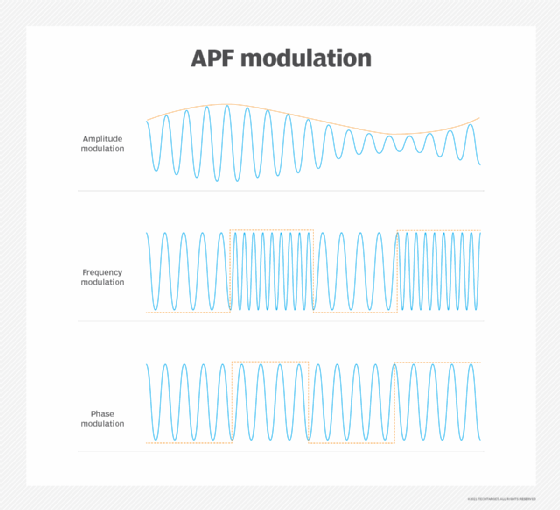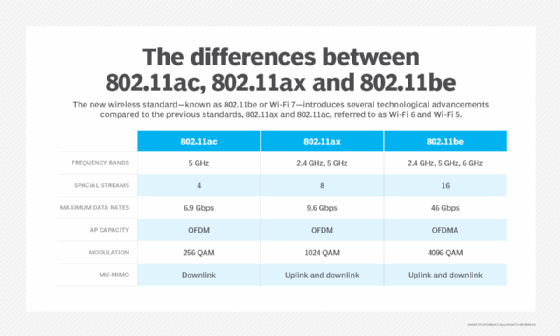What is QAM (quadrature amplitude modulation) and how does it work?
QAM (quadrature amplitude modulation) is a method of combining two amplitude modulation (AM) signals into a single channel. This modulation scheme helps double the channel's effective bandwidth. QAM is also used with pulse AM in digital systems, such as wireless communications.
How does QAM work?
QAM is used to achieve greater spectrum efficiency. This is accomplished by utilizing both the amplitude and phase components to modulate, or alter, the waveform. In this scenario, the QAM waveform consists of two signals, also known as carrier waves.
One signal is called the I signal, and the other is called the Q signal. This is why QAM is also known as IQ modulation. Mathematically, one of the signals can be represented with a sine wave and the other with a cosine wave. These carrier waves each have the same frequency but differ in phases by 90 degrees, or one-quarter of a cycle. Also, they are 90 degrees out of phase with each other, which is why they are said to be orthogonal to or in quadrature with each other. This is the basis for the term quadrature in QAM.
The two signals can be represented as follows:
cos (θ) = sin (θ-90°)
The two modulated carriers combine at the source -- within a QAM waveform -- for transmission. The modulator works like a translator. Its job is to encode, or translate, digital packets into an analog signal, thus ensuring seamless data transfers. The combined carrier signals are then transmitted over the same channel to the demodulator (receiver).
At the destination, the demodulator separates the carrier waves and extracts the data from each. A low-pass filter -- an electronic circuit that suppresses higher frequencies -- is used to extract the in-phase and quadrature components of the signal. Then, the data is incorporated into the original modulating information.

What is the difference between analog and digital QAM?
Some analog transmissions, like AM stereo, use QAM systems. However, QAM comes into its own in digital applications. This is because it offers a highly effective form of modulation for data when used in anything from smartphones to Wi-Fi infrastructure. QAM is found in most forms of high-speed data transmission.
Analog QAM also enables carriers to transmit multiple analog signals. For example, QAM is used in Phase Alternating Line and National Television System Committee systems. In this case, the different channels QAM provides enable the signal to carry components of color or chroma data.
A system known as Compatible QUAM is found in AM stereo broadcasting applications in the United States and some other countries. This scenario involves two distinct modulation stages: conventional AM and a compatible quadrature phase modulation. The different channels enable the required two channels for stereo to be carried by a single carrier. It uses dedicated circuitry to encode a stereo separation signal that is compatible with older receivers.
Digital versions of QAM are often called quantized QAM. They are built into most radio communications systems that use data. For example, radio communications technologies ranging from 4G and 5G cellular systems to Wi-Fi use different types of QAM. As the field evolves, the number of QAM systems used in radio communications technologies is likely to increase.
What is quadrature amplitude modulation in Wi-Fi?
QAM is commonly used in Wi-Fi networks because it enables higher data rates than other modulation schemes and improves spectral efficiency. Since the inception of Wi-Fi 5 (802.11ac) in 2013, many networking devices have used a type of QAM called 256-QAM. Varying the carrier waves in QAM enables engineers to create constellation diagrams with denser concentrations of symbols, or bit sequences. This increases data rates by transmitting more bits per hertz. As a higher-density scheme, 256-QAM can support up to 8 bits per symbol in 256 unique constellations.
The advent of Wi-Fi 6 (802.11ax) introduced a higher-order scheme, 1024-QAM. While it theoretically supports even higher data rates, it is more sensitive to interference.
QAM continues to be used with the latest Wi-Fi standard: Wi-Fi 7 (802.11be). Known as 4096-QAM or 4K-QAM, this method was adopted in 2024. In 4096-QAM, each signal is capable of carrying 12 bits. This provides 20% higher data rates than 1024-QAM in Wi-Fi 6. In addition to incorporating more data into each transmission, 4096-QAM also ensures wider, faster and more reliable Wi-Fi coverage. This can be a particularly important advantage for applications like 4K video streaming and online gaming, where fast data transmissions, low latency and high spectral efficiency are crucial.

What are the advantages and disadvantages of using QAM?
The primary benefit of QAM is that it offers more efficient bandwidth usage. This is because QAM represents more bits per carrier. For example, 256-QAM maps 8 bits per carrier wave, and 16-QAM maps 4 bits per carrier wave. Higher QAM orders allow for even more bits to be transmitted per signal. Thus, each signal can carry 10 bits in 1024-QAM, 11 bits in 2048-QAM and 12 bits in 4096-QAM. More bits per signal means higher bandwidth efficiency.
Another advantage of QAM is that it boosts the efficiency of radio communications transmissions. This is because it uses both the amplitude and phase variations to compress large volumes of digital information.
That said, there are also some significant disadvantages to this modulation method.
One disadvantage is that higher-order QAM schemes are more susceptible to noise and interference. This means a lower signal-to-noise ratio (SNR) and a higher bit error rate (BER). This is because the transmission states are close together, and there is a smaller distance between symbols. When a lower level of noise is required to move the signal from one point to another and if lower transmission rates are acceptable, a lower-order QAM scheme may be preferable.
Hardware complexity is another drawback of higher-order QAM schemes. Since these schemes support higher bit rates and are more prone to noise, additional hardware and signal processing algorithms may be needed to increase SNR and reduce BER. This can increase system complexity and maintenance cost.
Unlike QAM systems, receivers equipped with phase or frequency modulation can limit amplifiers and remove any amplitude noise. This approach improves its noise reliance. Furthermore, amplification of the phase or frequency modulated in a radio transmitter eliminates the need for linear amplifiers.
In QAM that contains an amplitude component, linearity must be maintained to ensure accurate, distortion-free amplification of the varying amplitude levels and to prevent errors during demodulation. Unfortunately, these linear amplifiers fall short when it comes to efficiency, and they consume more power. QAM receivers are also more complex when compared to those of other modulation types and systems. Therefore, they are not the best option for mobile applications.
What is QAM in cable TV?
QAM systems are popular in the cable television industry. In the U.S., for example, 64-QAM and 256-QAM are commonly used to deliver digital cable TV services. Multiple system operators (MSOs) and other network operators use QAM to deliver data, video and voice services. QAM systems provide formatting services in hubs where signals are processed and distributed over the cable operator's network. Once at the subscriber's home, cable modems and set-top boxes convert QAM signals back into their original format.
There's been an increasing need for QAM channels among network operators. This explosion in demand is being driven by consumers using high-definition televisions, high-speed data, video conferencing and more. From an overall cost perspective, MSOs need QAM.
Higher-order QAM schemes, like 1024-QAM and 4096-QAM, are used in newer wireless local area network devices and in ultra-high microwave backhaul systems.
Wi-Fi standards such as 802.11ac, 802.11ax and 802.11be vary in frequency bands, spatial streams and maximum data rates, with 802.11be providing the most significant enhancements. Learn about the 802.11 standards and how they differ.






